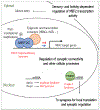Emerging roles for MEF2 in brain development and mental disorders
- PMID: 31129473
- PMCID: PMC6874740
- DOI: 10.1016/j.conb.2019.04.008
Emerging roles for MEF2 in brain development and mental disorders
Abstract
The MEF2 family of transcription factors regulate large programs of gene expression important for the development and maintenance of many tissues, including the brain. MEF2 proteins are regulated by neuronal synaptic activity, and they recruit several epigenetic enzymes to influence chromatin structure and gene expression during development and throughout adulthood. Here, we provide a brief review of the recent literature reporting important roles for MEF2 during early brain development and function, and we highlight emerging roles for MEF2 as a risk factor for multiple neurodevelopmental disorders and mental illnesses, such as autism, intellectual disability, and schizophrenia.
Copyright © 2019 Elsevier Ltd. All rights reserved.
Conflict of interest statement
Declarations of interest: none.
Figures



Similar articles
-
Emerging roles for MEF2 transcription factors in memory.Genes Brain Behav. 2014 Jan;13(1):118-25. doi: 10.1111/gbb.12058. Epub 2013 Jul 12. Genes Brain Behav. 2014. PMID: 23790063 Review.
-
Autism-Associated Chromatin Regulator Brg1/SmarcA4 Is Required for Synapse Development and Myocyte Enhancer Factor 2-Mediated Synapse Remodeling.Mol Cell Biol. 2015 Oct 12;36(1):70-83. doi: 10.1128/MCB.00534-15. Print 2016 Jan 1. Mol Cell Biol. 2015. PMID: 26459759 Free PMC article.
-
MEF2 transcription factors: developmental regulators and emerging cancer genes.Oncotarget. 2016 Jan 19;7(3):2297-312. doi: 10.18632/oncotarget.6223. Oncotarget. 2016. PMID: 26506234 Free PMC article. Review.
-
The MEF2 family and the brain: from molecules to memory.Cell Tissue Res. 2013 May;352(2):179-90. doi: 10.1007/s00441-013-1565-2. Epub 2013 Feb 9. Cell Tissue Res. 2013. PMID: 23397426 Review.
-
The Role of CREB, SRF, and MEF2 in Activity-Dependent Neuronal Plasticity in the Visual Cortex.J Neurosci. 2017 Jul 12;37(28):6628-6637. doi: 10.1523/JNEUROSCI.0766-17.2017. Epub 2017 Jun 12. J Neurosci. 2017. PMID: 28607167 Free PMC article.
Cited by
-
Transcriptomic and genomic studies classify NKL54 as a histone deacetylase inhibitor with indirect influence on MEF2-dependent transcription.Nucleic Acids Res. 2022 Mar 21;50(5):2566-2586. doi: 10.1093/nar/gkac081. Nucleic Acids Res. 2022. PMID: 35150567 Free PMC article.
-
MicroRNA profiling of the pig periaqueductal grey (PAG) region reveals candidates potentially related to sex-dependent differences.Biol Sex Differ. 2020 Dec 11;11(1):67. doi: 10.1186/s13293-020-00343-2. Biol Sex Differ. 2020. PMID: 33451362 Free PMC article.
-
Mef2c Controls Postnatal Callosal Axon Targeting by Regulating Sensitivity to Ephrin Repulsion.bioRxiv [Preprint]. 2025 Jan 22:2025.01.22.634300. doi: 10.1101/2025.01.22.634300. bioRxiv. 2025. Update in: J Neurosci. 2025 May 21;45(21):e0201252025. doi: 10.1523/JNEUROSCI.0201-25.2025. PMID: 39896513 Free PMC article. Updated. Preprint.
-
In the developing cerebral cortex: axonogenesis, synapse formation, and synaptic plasticity are regulated by SATB2 target genes.Pediatr Res. 2023 May;93(6):1519-1527. doi: 10.1038/s41390-022-02260-z. Epub 2022 Aug 26. Pediatr Res. 2023. PMID: 36028553
-
Transcriptomic analyses of human brains with Alzheimer's disease identified dysregulated epilepsy-causing genes.Epilepsy Behav. 2025 Jul;168:110421. doi: 10.1016/j.yebeh.2025.110421. Epub 2025 Apr 17. Epilepsy Behav. 2025. PMID: 40250147
References
-
- Leifer D, Golden J, and Kowall NW, Myocyte-specific enhancer binding factor 2C expression in human brain development. Neuroscience, 1994. 63(4): p. 1067–79. - PubMed
Publication types
MeSH terms
Substances
Grants and funding
LinkOut - more resources
Full Text Sources

